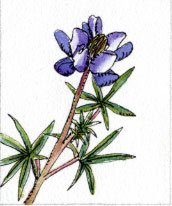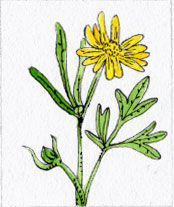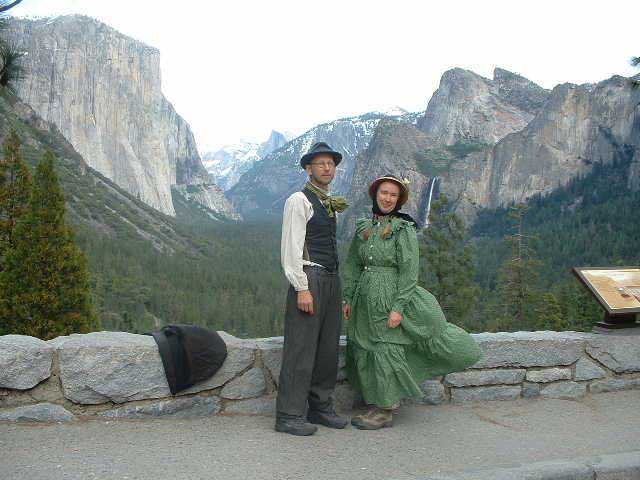Days 16 through 20
April 17
The skies were partially clear, and there was a thin layer of snow over our van left by the cold rainy night before. Rain was not predicted until next Friday, so we set out with hope of beautiful weather and many flowers. We were not disappointed. The first day we walked about 10 miles by the map, but it was 12.5 by our pedometers. We took lots of extra steps because there was so much elevation change. We walked from the Headquarters first to Poverty Flat, where we made our first of many creek crossings, and then on to Coit Lake. Because of the recent rains, the first crossing was pretty deep and we had to take off our pants, as the water went up to the top of our thighs. It was not as cold as in the Sierra, nor was it running too swiftly, so the crossing was actually pretty easy.
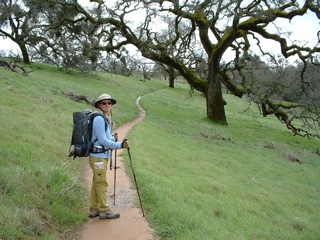
April 18.
We awoke by Coit Lake to find our tent nestled in a field of frost, but the sun shone brightly and it was soon gone. The day started with a river crossing. It was shallow, but still required us to remove our shoes. We pumped water from the creek, but it tasted like algae and I couldn't wait to find a spring so I could dump it. The first few miles had more of yesterday's flower displays and little bouquet gardens in the middle of the road, but as the trail rose and fell over consecutive ridges we were soon into a dry chaparral hillside habitat: scrubby ceanothus, black old Yerba Santa, poison oak, scraggly gray pines and rocky soil. We were going from spring to summer and back again as we rose and fell changing from north to south facing exposures, and we remembered Muir writing about the same phenomenon in his "Rambles of a Botanist".
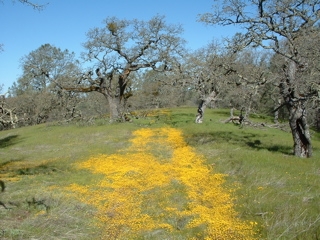
We rested by the creek. Donna painted, I wrote some, then closed my eyes and listened to the sounds of the water. I began to think about how often I do not stop to notice nature, maybe that is because it is hard to find nature to listen to in a city, but I imagine that really it is because I do not take the time. I remember what George told us and shift my focus from the river to the plants to see if I can hear them grow. The first thing I hear is an airplane overhead, but that soon passes, and again I hear only the creek. I think after that maybe I did hear the plants growing, but I may be mistaken.
We found the dirt ranch roads easy to walk, they are nicely graded and lined with beautiful flowers. The trails were slow, for they are often steep and overgrown, and we had to crawl over fallen trees and carefully pick our way around poison oak. But those trails took us to hidden glens with fairies and wildflowers that would not venture near the jeep traveled roads. The roads and trails just kept going and so did we, deciding to push on to Mustang Peak. Up, up, and just below the peak we found a nice campsite, right on the side of the road. I wish we could have camped out at the end of each day as we walked through Santa Clara and Alameda counties, but California's problem with transients and homeless precluded that option. I mean, we did see good campsites, but they all had been recently used by homeless and were mostly flooded out by the rain.
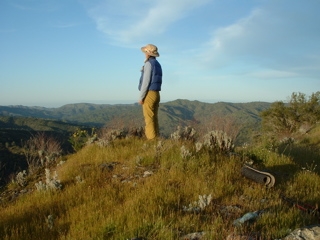
April 19.
There was no dew this morning. Just like two crazy John Muirs, we hopped out of bed to try to see the "Range of Light" at sunrise. There were already tinges of red in the sky so we fairly ran, trying to follow the little animal trail we had slogged up the night before. We had to sprint the last 200 feet (almost straight up) but got there in time to see, beyond the closer Diablos, a range of peaks and valleys, like a ghost in the distance. As the sun rose they became more distinct, and we tried to guess which was Yosemite Valley.
The park ended at Mustang Peak. Before the trip we spent a lot of time in correspondence and on the phone trying to obtain permission to walk through the private land to the east of the park, right across the Diablos to Santa Nella, Gustine or Newman. We were able to convince the ranchers along one of the routes that the project had enough historic merit to justify giving us permission to walk out of the Diablos on their private ranch roads. Most of the ranchers made us sign liability waivers with requirements to notify them when we would be on their land, so that the ranch hands would not apprehend us for trespassing. But one of the ranchers, a history buff and John Muir enthusiast, was so excited about the project that he gave us permission to spend the night in his hunting cabin. Go figure.
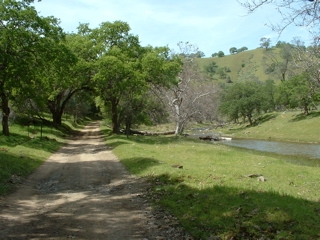
Later in the day we finally reached the hunting cabin. The creek had been dammed creating a pond. The cabin rested in the middle of a field of wildflowers, a shaded porch with rustic rocking chairs faced the pond, and a short path led to a little fishing dock. There was solar power and hot water. We sat on the porch for a long time just reveling in the tranquility. The pond was lined with grass and weeds, little reeds in the foreground and on the far side of the pond the hills rise and were spotted with newly leafed oaks. Birds called, two coots landed in the water, frogs croaked and the wind blew through the trees. The sun shined, the water gurgled as it passed over a fall. I sat there so long I could see the time pass by the shadows of the trees, and I could start to hear the plants growing. Donna and I mused, "When have we been in a more idyllic place?" We wondered if Muir would have stopped to enjoy a few hours on the shaded porch of this rustic cabin, or would he have been climbing the hills in search of his elusive orchid? Times have changed; his Portage, Wisconsin home was probably just like this, but such serene and pastoral places are now few and far between, and as rare as Muir's Calypso Borealis. It was a Shangri-La, and we could believe it was real or that following Muir's footsteps has brought us there.
We ate dinner then walked further down the road. It was the time just before twilight and the walk was like a dessert. The wildflowers that were absent at the beginning of the day reappeared along the creek: butter and eggs, the goldenbush, a whiter kind of gilia, short lavender lupines, and hillsides of purple. The ceanothus smells like some exotic sweet sandalwood incense. We walked until dark and camped just before getting to a ranch that 8 miles of the road pass through and we only had permission to walk through in the morning.
April 20
It is 40 degrees at dawn, but by the time we start walking it is already 60, and by the end of the day Donna is sure the thermometer is broken, stuck at 80 from being left in the sun, but it is a beautiful warm. We begin with three or four river crossings that, with the aid of our hiking poles, we can make without removing our shoes. But then we encounter crossing after crossing that are too deep and wide to make without removing our shoes. Donna realizes that she has not yet painted a Goldenbush, and that we may be dropping below its elevation, so stops to paint it. Just then a truck drives around the corner below us. "Busted" we think, but no, it is friendly hunters who cannot stop either, and they wave then continue along. We continue to follow the creek down this ancient river valley. There are gray pines on the south facing slopes and oaks on the other side, but the oaks are topped by gray pines up near the ridge. There are flowers, it is pastoral, we are walking along, minding our own business as instructed and turn a corner to find a herd of 30 cows, about 8 of them are bulls (horns and all) and when they see us they all stop and turn to stare at us. The bulls do that little thing they do, lowering their head and staring, and we begin to wish that we had spent more time on a dude ranch, or gone to ranchers summer camp when we were kids. We try to walk off the road around them, but as we pass they all take off down the road, all except the biggest bull, who just stares at us. If John Muir were here he would have known what to do, but we don't. We keep our distance, looking for trees to hide behind, and keep walking and finally the bull takes off after the rest. The herd stops and we try to get around them again, but they take off down the road again. Now we begin to worry that we will get in trouble for moving the herd, but we can't do anything about it they just keep running from us. Finally we come to a cattle guard on the road, and they can't cross. The bulls stand guard, but as we approach they move aside, and we jump across the guard to safety.
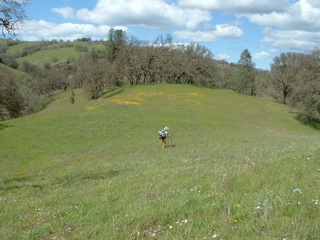
April 21, 2006 Day 20
We have crossed the Diablo Range and are now in Gustine. It was a long walk out of the little valley, and as we walked towards Gustine we watched it fade and shrink in the distance. We walked for a while up the California Aqueduct, and then started off on small roads to find the Main Canal, which we were going to follow to Gustine. As soon as we got on the roads we made a wrong turn and walked a half mile out of our way. We finally found the canal and walked on the little maintenance road beside it. The water was almost to the bottom of the bridges, as there has been so much rain.
We walked 14 miles and were to the edge of town. Just as we arrived at the park in the center of town, about 2pm, Shirley from the Gustine Press Standard drove by with her head out the window, "are you the two walking to Yosemite?" She interviewed us in the park. (the story should appear next week.) Ron came to save us... picked us up and drove us back to get our VW at Henry Coe Park.
